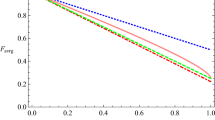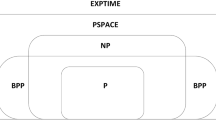Abstract
Quantum-dot cellular automata (QCA) circuits are not based on transistors. Therefore, novel concepts and methodologies are required to be able to design Boolean functions in a systematic manner. Wire crossing is a problematic challenge in this technology, imposing considerable cost, complexity, and noise sensitivity. On the other hand, QCA circuits with multiple successive majority gates experience long delays. This paper deals with both problems. At first, some new diagrams are presented for the 13 standard functions, which are sufficient to represent all of the three-input Boolean functions. Some of the standard functions are designed with much fewer wire crossings in this paper compared with the previous designs. Then, with the aim of reducing delay, hierarchical multiplexers are merged together in order to generate wide Boolean functions with fewer layers of majority gates. Circuit compactness is based on some new merging rules.








Similar content being viewed by others
References
Moore, G.E.: Cramming more components onto integrated circuits. Electronics 38, 114–117 (1965)
International Technology Roadmap for Semiconductors 2.0, 2015 edn. https://www.semiconductors.org/clientuploads/Research_Technology/ITRS/2015/0_2015%20ITRS%202.0%20Executive%20Report%20(1).pdf. Accessed Nov 2017
Courtland, R.: Transistors could stop shrinking in 2021. IEEE Spectr. 53, 9–11 (2016)
Waldrop, M.M.: The chips are down for Moore’s law. Nature 530, 144–147 (2016)
Lent, C.S., Tougaw, P.D., Porod, W., Bernstein, G.H.: Quantum cellular automata. Nanotechnology 4, 49–57 (1993)
Lent, C.S., Tougaw, P.D.: A device architecture for computing with quantum dots. Proc. IEEE 85, 541 (1997)
Dehon, A., Wilson, M.J.: Nanowire-based sublithographic programmable logic arrays. In: Proceedings of International Symposium on Field-Programmable Gate Arrays, pp. 123–132 (2004)
Seminario, J.M.: A molecular device operating at terahertz frequencies: theoretical simulations. IEEE Trans. Nanotechnol. 3, 368–376 (2004)
Zhang, R., Gupta, P., Jha, N.K.: Majority and minority network synthesis with application to QCA-, SET-, and TPL-based nanotechnologies. IEEE Trans. Comput. Aided Des. Integr. Circuits Syst. 26, 1233–1245 (2007)
Ahmad, F., Bhat, G.M., Khademolhosseini, H., Azimi, S., Angizi, S., Navi, K.: Towards single layer quantum-dot cellular automata adders based on explicit interaction of cells. J. Comput. Sci. 16, 8–15 (2016)
Abedi, D., Jaberipur, G., Sangsefidi, M.: Coplanar full adder in quantum-dot cellular automata via clock-zone-based crossover. IEEE Trans. Nanotechnol. 14, 497–504 (2015)
Zhang, R., Walus, K., Wang, W., Jullien, G.A.: A method of majority logic reduction for quantum cellular automata. IEEE Trans. Nanotechnol. 3, 443–450 (2004)
Momenzadeh, M., Huang, J., Tahoori, M.B., Lombardi, F.: Characterization, test, and logic synthesis of And-Or-Inverter (AOI) gate design for QCA implementation. IEEE Trans. Comput. Aided Des. Integr. Circuits Syst. 24, 1881–1893 (2005)
Taherifard, M., Fathy, M.: Improving logic function synthesis, through wire crossing reduction in quantum-dot cellular automata layout. IET Circuits Dev. Syst. 9, 265–274 (2015)
Sen, B. Sengupta, A., Dalui, M., Sikdar, B.K.: Design of testable universal logic gate targeting minimum wire-crossings in QCA logic circuit. In: 13th Euromicro Conference on Digital System Design: Architectures, Methods and Tools, pp. 613–620 (2010)
Roohi, A., Menbari, B., Shahbazi, E., Kamrani, M.: A genetic algorithm based logic optimization for majority gate-based QCA circuits in nanoelectronics. Quantum Matter 2, 219–224 (2013)
Wang, P., Niamat, M., Vemuru, S.: Minimal majority gate mapping of four-variable functions for quantum-dot cellular automata. In: Nanoelectronic Device Applications Handbook. CRC Press, Boca Raton, pp. 267–284 (2013)
Singhal, R.: Logic realization using regular structures in quantum-dot cellular automata (QCA). Master’s Thesis, Portland State University, United States (2011)
Shin, S.H., Jeon, J.C., Yoo, K.Y.: Wire-crossing technique on quantum-dot cellular automata. In: 2nd International Conference on Next Generation Computer and Information Technology, pp. 52–57 (2013)
Liu, W., Swartzlander Jr., E.E., O’Neill, M.: Design of Semiconductor QCA Systems. Artech House, Norwood (2013)
Swartzlander Jr., E.E., Cho, H., Kong, I., Kim, S.W.: Computer arithmetic implemented with QCA: a progress report. In: 44th Asilomar Conference on Signals, Systems and Computers, pp. 1392–1398 (2010)
Bhanja, S., Ottavi, M., Lombardi, F., Pontarelli, S.: QCA circuits for robust coplanar crossing. J. Electron. Test. 23, 193–210 (2007)
Janez, M., Pecar, P., Mraz, M.: Layout design of manufacturable quantum-dot cellular automata. Microelectron. J. 43, 501–513 (2012)
Labrado, C., Thapliyal, H.: Design of adder and subtractor circuits in majority logic-based field-coupled QCA nanocomputing. Electron. Lett. 52, 464–466 (2016)
Roohi, A., Zand, R., Angizi, S., DeMara, R.F.: A parity-preserving reversible QCA gate with self-checking cascadable resiliency. In: IEEE Transactions on Emerging Topics in Computing, pp. 1–10 (2016)
Bararzadeh, M., Mohammadyan, S., Navi, K., Bagherzadeh, N.: A novel low-power Exclusive-OR via cell level-based design function in quantum cellular automata. J. Comput. Electron. 1–8 (2017)
QCADesigner. https://waluslab.ece.ubc.ca/qcadesigner/. Accessed Nov 2017
Walus, K., Dysart, T.J., Jullien, G.A., Budiman, R.A.: QCADesigner: a rapid design and simulation tool for quantum-dot cellular automata. IEEE Trans. Nanotechnol. 3, 26–31 (2004)
Srivastava, S., Asthana, A., Bhanja, S., Sarkar, S.: QCAPro: an error-power estimation tool for QCA circuit design. In: IEEE International Symposium on Circuits and Systems, pp. 2377–2380 (2011)
Navi, K., Sayedsalehi, S., Farazkish, R., Azghadi, M.R.: Five-input majority gate, a new device for quantum-dot cellular automata. J. Comput. Theor. Nanosci. 7, 1546–1553 (2010)
Navi, K., Farazkish, R., Sayedsalehi, S., Azghadi, M.R.: A new quantum-dot cellular automata full-adder. Microelectron. J. 41, 820–826 (2010)
Akeela, R., Wagh, M.D.: A five-input majority gate in quantum-dot cellular automata. NSTI Nanotechnol. 2, 13–16 (2011)
Angizi, S., Sarmadi, S., Sayedsalehi, S., Navi, K.: Design and evaluation of new majority gate-based RAM cell in quantum-dot cellular automata. Microelectron. J. 46, 43–51 (2015)
Orlov, A., Amlani, I., Toth, G., Lent, C., Bernstein, G., Snider, G.: Experimental demonstration of a binary wire for quantum-dot cellular automata. Appl. Phys. Lett. 74, 2875–2877 (1999)
Liu, W., Lu, L., O’Neill, M., Swartzlander Jr., E.E.: A first step toward cost functions for quantum-dot cellular automata designs. IEEE Trans. Nanotechnol. 13, 476–487 (2014)
Akers, S.B.: A rectangular logic array. IEEE Trans. Comput. C-21, 848–857 (1972)
Navi, K., Chabi, A.M., Sayedsalehi, S.: A novel seven input majority gate in quantum-dot cellular automata. Int. J. Comput. Sci. Issues 9, 84–89 (2012)
Amaru, L., Gaillardon, P.E., Chattopadhyay, A., De Micheli, G.: A sound and complete axiomatization of majority-n logic. IEEE Trans. Comput. 65, 2889–2895 (2016)
Chattopadhyay, A., Amaru, L., Soeken, M., Gaillardon, P.E., De Micheli, G.: Notes on majority Boolean algebra. In: IEEE 46th International Symposium on Multiple-Valued Logic, pp. 50–55 (2016)
Amaru, L., Gaillardon, P.E., De Micheli, G.: Majority-inverter graph: a new paradigm for logic optimization. IEEE Trans. Comput. Aided Des. Integr. Circuits Syst. 35, 806–819 (2016)
Author information
Authors and Affiliations
Corresponding author
Appendix
Appendix
See Fig. 9.
Rights and permissions
About this article
Cite this article
Tahmasebi, M., Faghih Mirzaee, R. & Pishgar Komleh, S.H. On the design methodology of Boolean functions with quantum-dot cellular automata for reducing delay and number of wire crossings. J Comput Electron 17, 1756–1770 (2018). https://doi.org/10.1007/s10825-018-1219-4
Published:
Issue Date:
DOI: https://doi.org/10.1007/s10825-018-1219-4







